Mechanical Properties and Seismic Loss Assessment of Improved Isolation Bearing with Variable Stiffness
Abstract
1. Introduction
2. Mechanical Properties of Improved Isolation Bearings
2.1. Theoretical Analysis and Design of Improved Isolation Bearing
2.2. Finite Element Analysis of Improved Isolation Bearing
2.2.1. Material Constitutive Model
- (1)
- Constitutive model of rubber
- (2)
- Constitutive model of lead core
- (3)
- Constitutive model of steel
2.2.2. Finite Element Model of Isolation Bearing
2.2.3. Element Selection and Meshing
2.2.4. Boundary Conditions and Loading Scheme
2.3. Results and Analysis
2.3.1. Compressive Mechanical Properties of Isolation Bearings
2.3.2. Horizontal Compression-Shear Mechanical Properties of Isolation Bearings
2.4. Restoring Force Model of Improved Isolation Bearing
- (1)
- The OA section is the positive elastic stage, and the initial stiffness k1 is the stiffness of the rubber layer at the lower part of the isolation bearing: .
- (2)
- The AB section is the plastic yielding stage, and the yield stiffness k2 is the parallel stiffness of the rubber layers at the upper and lower parts of the isolation bearing: .
- (1)
- The OA section is the positive elastic stage, and the initial stiffness k1 is the stiffness of the rubber layer at the lower part of the isolation bearing: .
- (2)
- The AB section is the plastic yielding stage, and the yield stiffness k2 is the parallel stiffness of the rubber layers at the upper and lower parts of the isolation bearing: .
- (3)
- The BC section is the plastic hardening stage, and the yield stiffness k3 is the stiffness of the rubber layer at the upper part of the isolation bearing: .where G1 is the shear modulus of of the rubber layer at the lower part of the isolation bearing; G2 is the shear modulus of of the rubber layer at the upper part of the isolation bearing; A is the plane area of the rubber layer; is the total thickness of the rubber layer.
3. Earthquake Loss Assessment of Isolation Structures
3.1. Establishment of Isolation Structure Models
3.2. Vulnerability Analysis
3.2.1. Structural Performance Level
3.2.2. Analysis of IDA
3.2.3. Seismic Vulnerability Curve
3.3. Performance Assessment Theory for FEMA P-58
3.4. PACT Performance Calculation Software
3.5. Basic Information of the Building
3.6. Model of Personnel Flow
3.7. Vulnerability Grouping and Performance Grouping of Members
3.8. Results and Analysis
3.8.1. Analysis of the Assessment Results of Repair Costs
3.8.2. Analysis of the Assessment Results of Casualties
4. Conclusions
- The proposed improved isolation bearing provides a small horizontal stiffness to extend the structural period under frequent earthquakes and fortification earthquakes by using the low shear modulus rubber and the limiting device. Under rare earthquakes, it provides damping and large horizontal stiffness to avoid excessive displacement of the bearing. The numerical analysis results prove that the improved isolation bearing can reasonably and effectively solve the defect of the traditional rubber bearing.
- The limiting device divides the working conditions of the improved isolation bearing into two types. In the first condition, the isolation bearing maintains a small horizontal stiffness, which can give full play to the seismic isolation performance of the isolation bearing, but almost no energy dissipation capacity. In the second working condition, the horizontal stiffness of the isolation bearing is improved, and the lead core gives full play to the energy dissipation characteristics.
- A simplified restoring force model of the improved isolation bearing is proposed. The restoring force model of the isolation bearing is a double-line model in the first working condition, and a three-line model in the second working condition. The theoretical calculation results of stiffness are in good agreement with the numerical analysis results, which proves the reliability of the model.
- The required for the improved isolation structure is maximum at all four performance levels. The probability of serious damage (collapse) for the three structures under the rare earthquake ( = 0.9 g) is 64.84%, 16.34%, and 12.14%, respectively. It is proved that the improved isolation structure has the highest safety reserve and the best collapse resistance.
- Comparing the results of the earthquake loss assessment of the structures, the repair costs and the number of casualties of the normal isolation structure and the improved isolation structure are far lower than that of the normal frame structure. The loss of the normal isolation structure and the improved isolation structure mostly comes from non-structural members, which effectively reduces the damage of structural members. The improved isolation structure requires the least repair cost under frequent earthquakes. The application of the improved isolation bearing has effectively reduced the number of casualties under strong earthquakes. In addition, the casualties in the building are mainly caused by the damage of acceleration-sensitive members, so the acceleration-sensitive members should be reasonably arranged during the design.
Author Contributions
Funding
Data Availability Statement
Conflicts of Interest
References
- Mostaghel, N.; Tanbakuchi, J. Response of sliding structures to earthquake support motion. Earthq. Eng. Struct. D 1983, 11, 729–748. [Google Scholar] [CrossRef]
- Derham, C.J.; Kelly, J.M.; Thomas, A.G. Nonlinear natural rubber bearings for seismic isolation. Nucl. Eng. Des. 1985, 84, 417–428. [Google Scholar] [CrossRef]
- Lin, T.W.; Hone, C.C. Base isolation by free rolling rods under basement. Earthq. Eng. Struct. D 1993, 22, 261–273. [Google Scholar] [CrossRef]
- Marano, G.C.; Greco, R. Efficiency of base isolation systems in structural seismic protection and energetic assessment. Earthq. Eng. Struct. D 2003, 32, 1505–1531. [Google Scholar] [CrossRef]
- Matsagar, V.A.; Jangid, R.S. Seismic response of base-isolated structures during impact with adjacent structures. Eng. Struct. 2003, 25, 1311–1323. [Google Scholar] [CrossRef]
- Zaragar, H.; Ryan, K.L.; Marshall, J.D. Feasibility study of a gap damper to control seismic isolator displacements in extreme earthquakes. Struct. Control Health 2013, 20, 1159–1175. [Google Scholar] [CrossRef]
- Karayel, V.; Yuksel, E.; Gokce, T.; Sahin, F. Spring tube braces for seismic isolation of buildings. Earthq. Eng. Eng. Vib. 2017, 16, 219–231. [Google Scholar] [CrossRef]
- Wilde, K.; Gardoni, P.; Fujino, Y. Base isolation system with shape memory alloy device for elevated highway bridges. Eng. Struct. 2000, 22, 222–229. [Google Scholar] [CrossRef]
- Xue, S.; Li, X. Control devices incorporated with shape memory alloy. Earthq. Eng. Eng. Vib. 2007, 6, 159–169. [Google Scholar] [CrossRef]
- Hosseini, R.; Rashidi, M.; Bulajić, B.D.; Arani, K.K. Multi-Objective Optimization of Three Different SMA-LRBs for Seismic Protection of a Benchmark Highway Bridge against Real and Synthetic Ground Motions. Appl. Sci. 2020, 10, 4076. [Google Scholar] [CrossRef]
- Behrooz, M.; Wang, X.; Gordaninejad, F. Performance of a new magnetorheological elastomer isolation system. Smart Mater. Struct. 2014, 23, 045014. [Google Scholar] [CrossRef]
- Yang, J.; Christie, M.D.; Sun, S.; Ning, D.H.; Nakano, M.; Li, Z.X.; Du, H.; Li, W.H. Integration of an omnidirectional self-powering component to an MRE isolator towards a smart passive isolation system. Mech. Syst. Signal Process. 2020, 144, 106853. [Google Scholar] [CrossRef]
- Yuan, S.J.; Sun, Y.; Zhao, J.L.; Meng, K.; Wang, M.; Pu, H.Y.; Peng, Y.; Luo, J.; Xie, S.R. A tunable quasi-zero stiffness isolator based on a linear electromagnetic spring. J. Sound Vib. 2020, 482, 115449. [Google Scholar] [CrossRef]
- Rahnavard, R.; Thomas, R.J. Numerical evaluation of steel-rubber isolator with single and multiple rubber cores. Eng. Struct. 2019, 198, 109532. [Google Scholar] [CrossRef]
- Rahnavard, R.; Craveiro, H.D.; Napolitano, R. Static and dynamic stability analysis of a steel-rubber isolator with rubber cores. Structures 2020, 26, 441–455. [Google Scholar] [CrossRef]
- Isakovic, T.; Fischinger, M. Applicability of variable stiffness seismic isolators based on magnetically controlled elastomer. In Improvement of Buildings’ Structural Quality by New Technologies; CRC Press: Boca Raton, FL, USA, 2005; pp. 689–694. [Google Scholar]
- Li, Y.M.; Ma, Y.H.; Zhao, G.F.; Liu, R. Study on the Basic Performance Deterioration Law and the Application of Lead Rubber Bearings under the Alternation of Aging and Seawater Erosion. Buildings 2023, 13, 360. [Google Scholar] [CrossRef]
- Huang, X.; Hu, Z.X.; Liu, Y.L.; Nie, L.Q. Study on Seismic Performance of TID-LRB Hybrid Control System under Multi-Level Earthquakes. Buildings 2022, 12, 1465. [Google Scholar] [CrossRef]
- Gao, J.; Xue, Y.T.; Xiao, C.Z.; Zhou, X.Y.; Han, X. Experimental study on variable stiffness laminated rubber isolation bearing of series connection type. Build. Struct. 2020, 50, 109–113. [Google Scholar]
- Peng, T.; Guan, J.; Wu, Y. Numerical and Experimental Investigation of the Seismic Effect of a Two-Stage Seismic Isolation Method. Sustainability 2023, 15, 4883. [Google Scholar] [CrossRef]
- FEMA. Seismic Performance Assessment of Buildings Volume 1-Methodology; Federal Emergency Management Agency: Washington, DC, USA, 2012.
- Sun, Y.T.; Zhang, J.F.; Li, G.C.; Wang, Y.H.; Sun, J.B.; Jiang, C. Optimized neural network using beetle antennae search for predicting the unconfined compressive strength of jet grouting coalcretes. Int. J. Numer. Anal. Met. 2019, 43, 801–813. [Google Scholar] [CrossRef]
- Sun, J.B.; Wang, Y.F.; Yao, X.P.; Ren, Z.H.; Zhang, G.B.; Zhang, C.; Chen, X.G.; Ma, W.; Wang, X.Y. Machine-learning-aided prediction of flexural strength and ASR expansion for waste glass cementitious composite. Appl. Sci. 2021, 11, 6686. [Google Scholar] [CrossRef]
- Tang, Y.C.; Feng, W.H.; Chen, Z.; Nong, Y.M.; Guan, S.H.; Sun, J.B. Fracture behavior of a sustainable material: Recycled concrete with waste crumb rubber subjected to elevated temperatures. J. Clean. Prod. 2021, 318, 128553. [Google Scholar] [CrossRef]
- Zhang, G.B.; Chen, C.F.; Li, K.F.; Xiao, F.; Sun, J.B.; Wang, Y.F.; Wang, X.Y. Multi-objective optimisation design for GFRP tendon reinforced cemented soil. Constr. Build. Mater. 2022, 320, 126297. [Google Scholar] [CrossRef]
- Sun, J.B.; Tang, Y.C.; Wang, J.Q.; Wang, X.Y.; Wang, J.Q.; Yu, Z.M.; Cheng, Q.; Wang, Y.F. A multi-objective optimisation approach for activity excitation of waste glass mortar. J. Mater. Res. Technol. 2022, 17, 2280–2304. [Google Scholar] [CrossRef]
- Sun, Y.T.; Bi, R.Y.; Sun, J.B.; Zhang, J.F.; Taherdangkoo, R.; Huang, J.D.; Li, G.C. Stability of roadway along hard roof goaf by stress relief technique in deep mines: A theoretical, numerical and field study. Geomech. Geophys. Geo-Energy Geo-Resour. 2022, 8, 45. [Google Scholar] [CrossRef]
- CECS 126:2001; Technical Specification for Seismic-Isolation with Laminated Rubber Bearings Isolators. Standards Press of China: Beijing, China, 2001.
- GB/T 20688.1-2007; Rubber Bearings—Part 1: Seismic-Protection Isolators Test Methods. Standards Press of China: Beijing, China, 2007.
- GB/T 20688.3-2006; Rubber Bearings—Part 3: Elastomeric Seismic-Protection Isolators for Buildings. Standards Press of China: Beijing, China, 2006.
- GB/T 20688.4-2007; Rubber Bearings—Part 4: Normal Rubber Bearings. Standards Press of China: Beijing, China, 2007.
- Kilian, H.G. Equation of state of real networks. Polymers 1981, 22, 209–217. [Google Scholar] [CrossRef]
- Arruda, E.M.; Boyce, M.C. A three-dimensional constitutive model for the large stretch behavior of rubber elastic materials. J. Mech. Phys. Solids. 1993, 41, 389–412. [Google Scholar] [CrossRef]
- Mooney, M. A theory of large elastic deformation. J. Appl. Phys. 1940, 11, 582–592. [Google Scholar] [CrossRef]
- Rovlin, R.S. Large elastic deformations of isotropic materials IV. Further development of general theory. Phil. Trans. R. Soc. A 1948, 241, 379–397. [Google Scholar]
- Yeoh, O.H. Characterization of elastic properties of carbon-black-filled rubber vulcanizates. Rubber Chem. Technol. 1990, 63, 792–805. [Google Scholar] [CrossRef]
- Zheng, M.J.; Wang, W.J.; Chen, Z.N.; Wu, L.J. Determination for mechanical constants of rubber Mooney-Rivlin model. China Rubber Ind. 2003, 8, 462–465. [Google Scholar]
- Huang, J.L.; Xie, G.J.; Liu, Z.W. Finite element analysis of super-elastic rubber materials based on the Mooney-Rivlin and Yeoh model. China Rubber/Plast. Technol. Eq. 2008, 34, 22–26. [Google Scholar]
- Liu, M.; Wang, Q.C.; Wang, G.Q. Determination of material constants in rubber Mooney-Rivlin model. China Rubber Ind. 2011, 58, 241–245. [Google Scholar]
- GB 50011-2010; Code for Seismic Design of Buildings. China Architecture & Building Press: Beijing, China, 2015.
- GB 50016-2014; Code for Fire Protection Design of Building. China Architecture & Building Press: Beijing, China, 2014.
- GB 50010-2010; Code for Design of Concrete Structures. China Architecture & Building Press: Beijing, China, 2015.
- GB 50009-2012; Load Code for the Design of Building Structures. China Architecture & Building Press: Beijing, China, 2012.
- FEMA. Seismic Performance Assessment of Buildings Volume 2-Implementation Guide; Federal Emergency Management Agency: Washington, DC, USA, 2012.
- GB/T 38591-2020; Standard for Seismic Resilience Assessment of Buildings. Standards Press of China: Beijing, China, 2020.


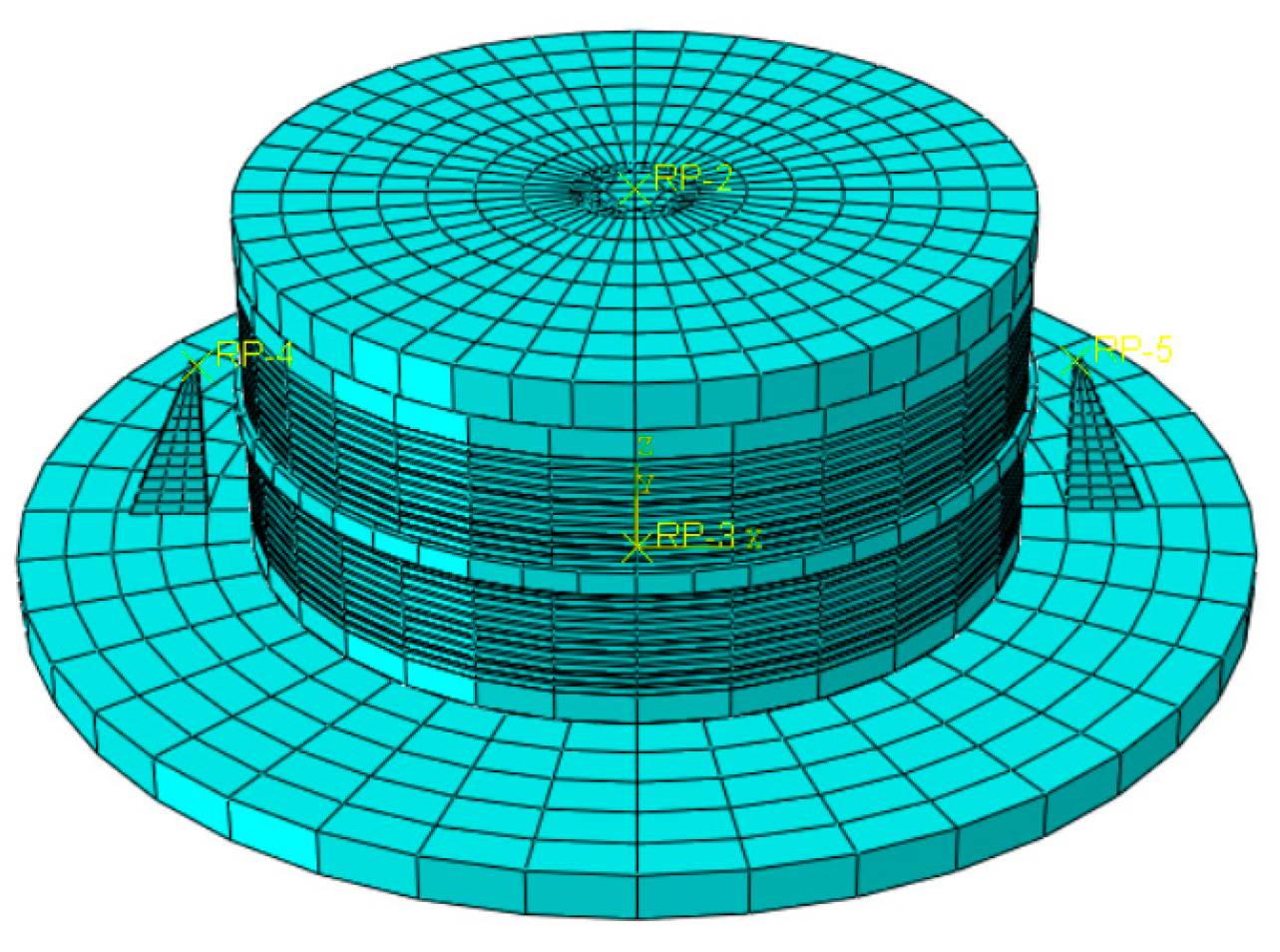
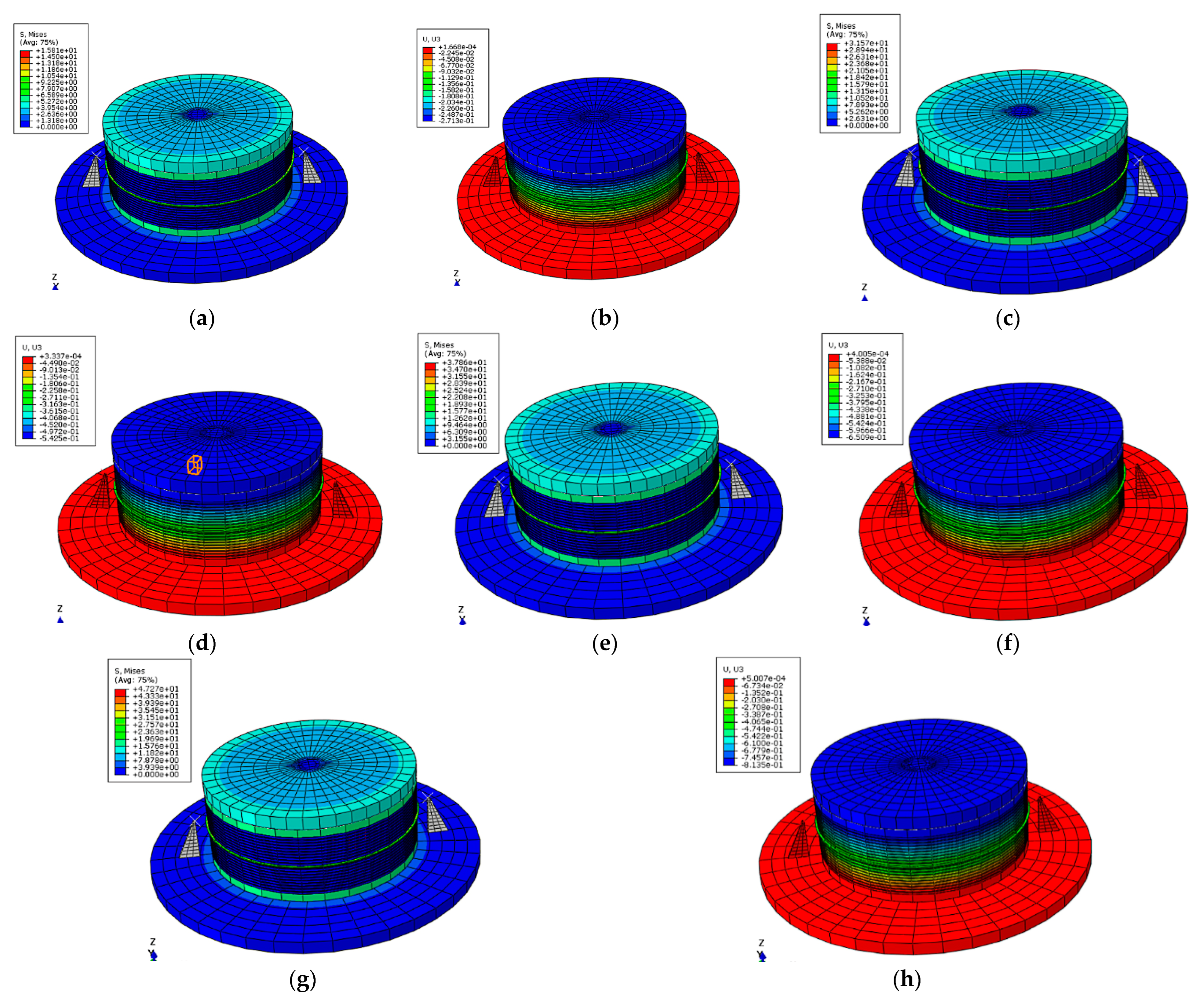

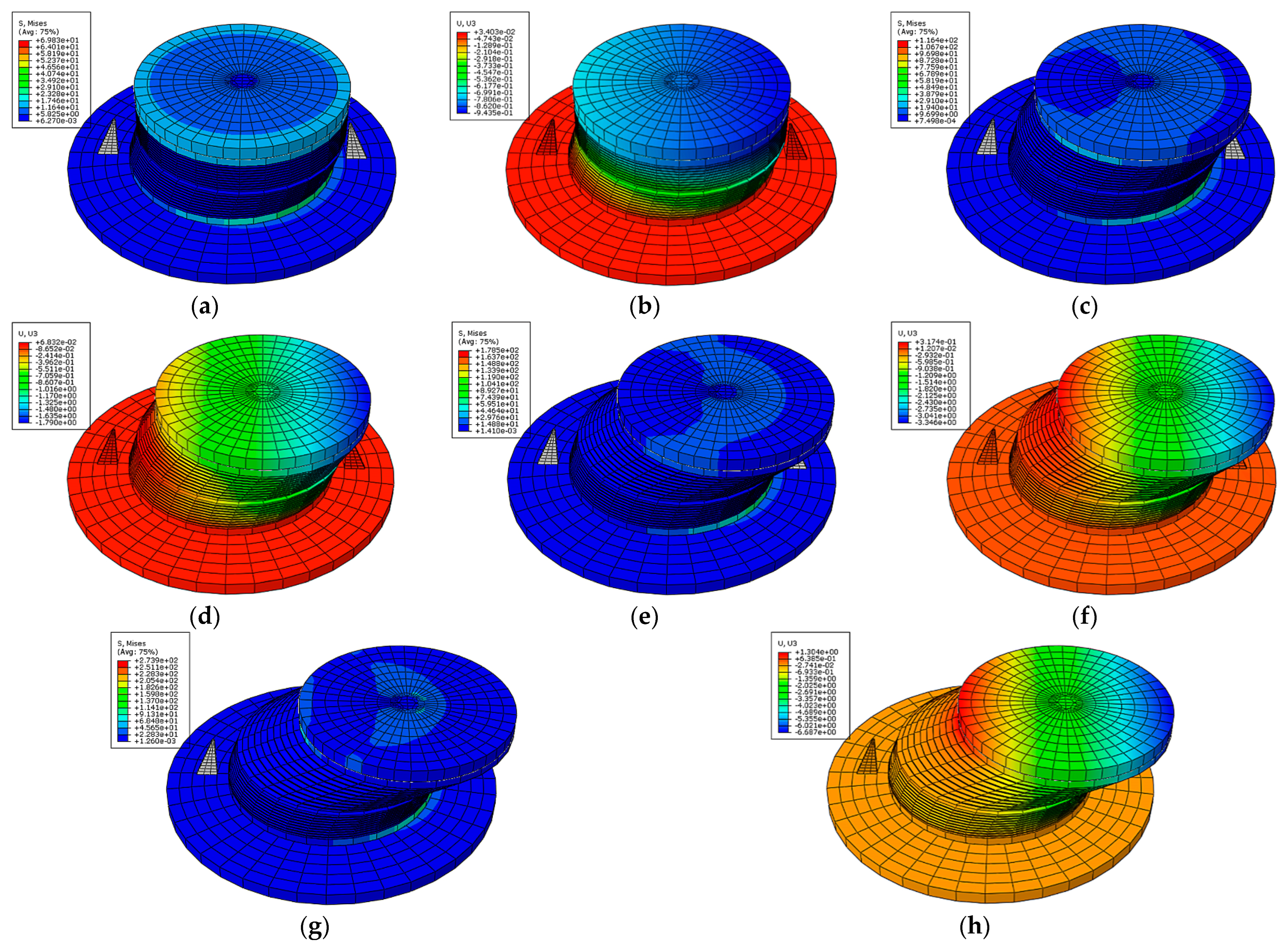

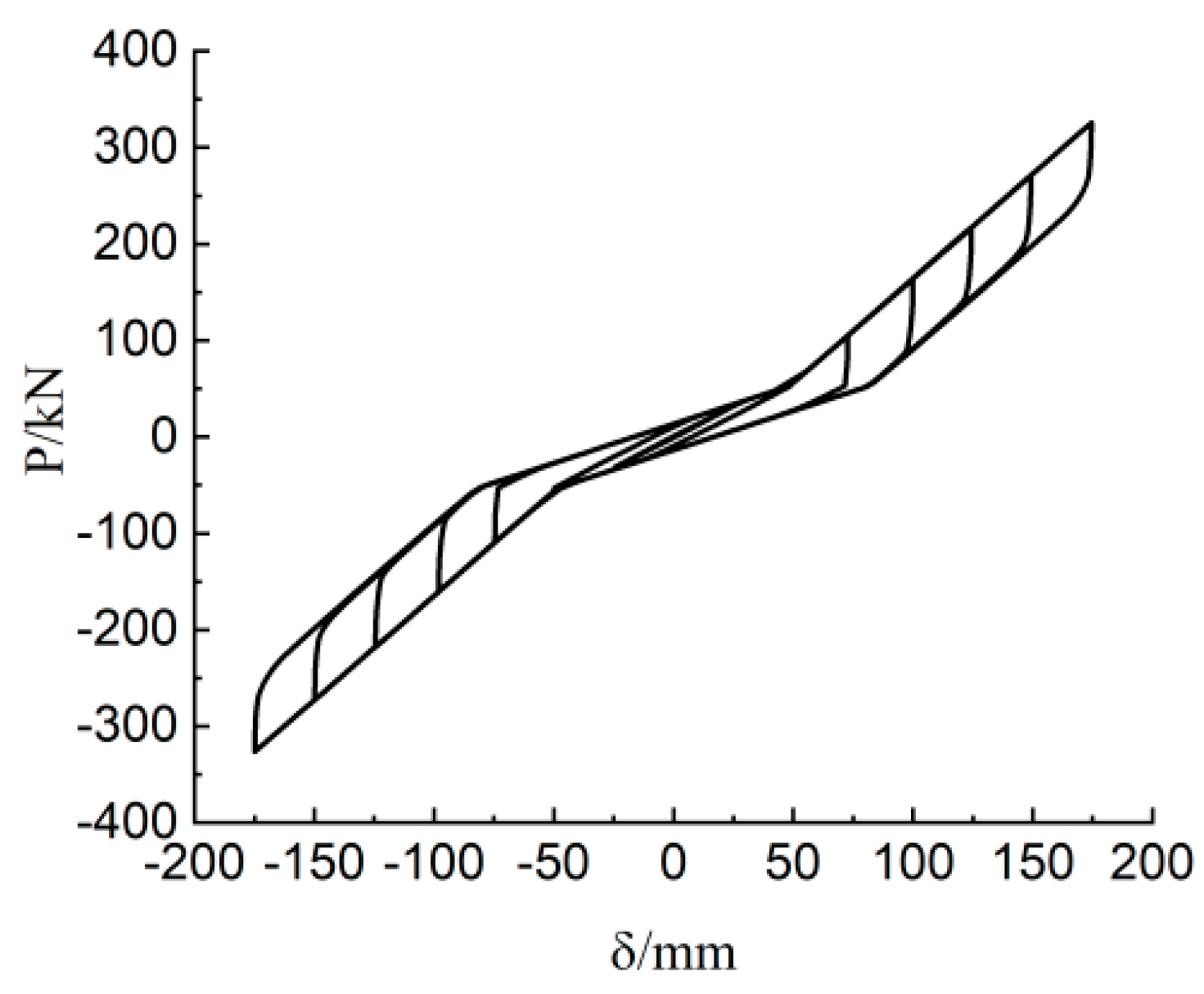
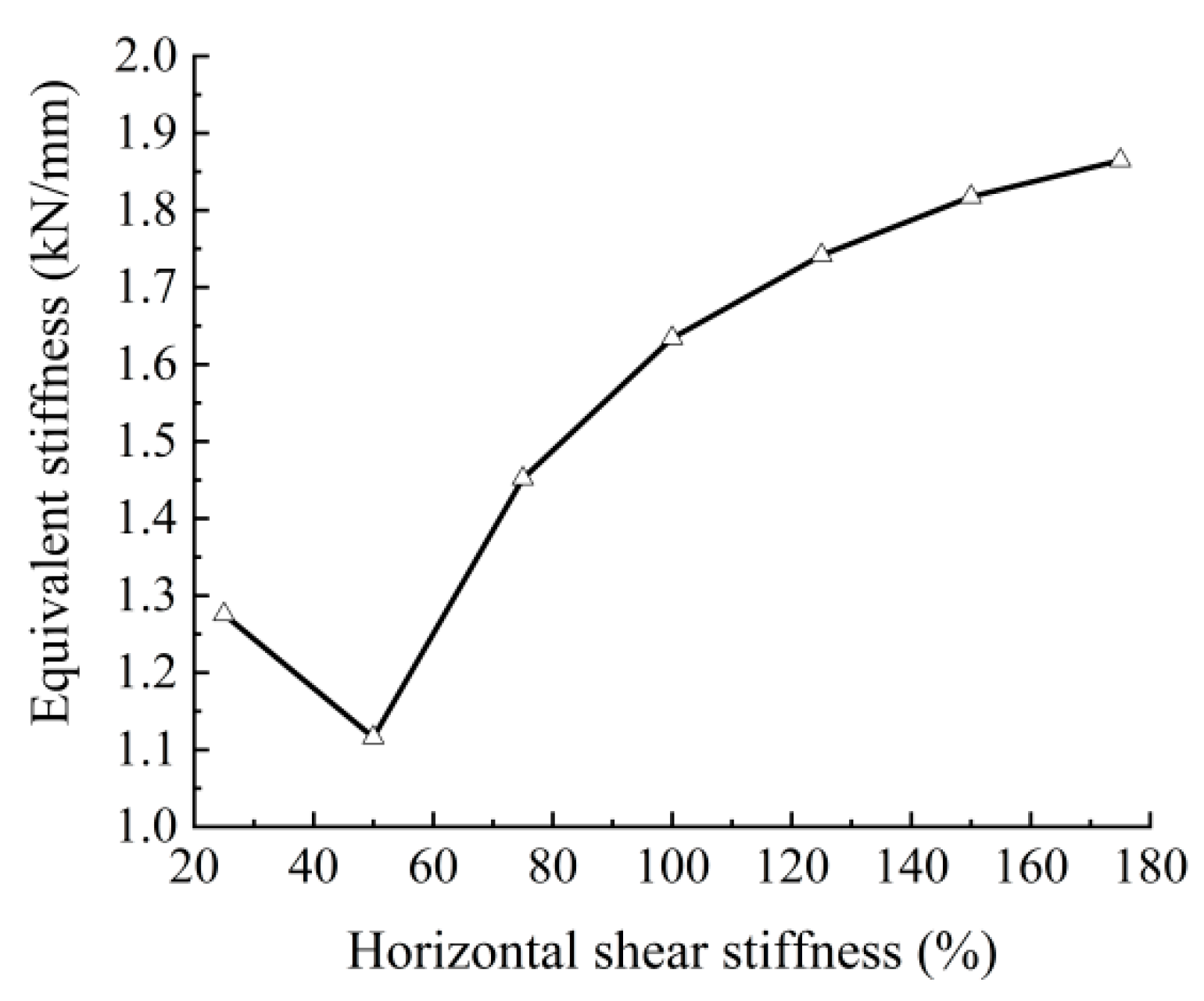

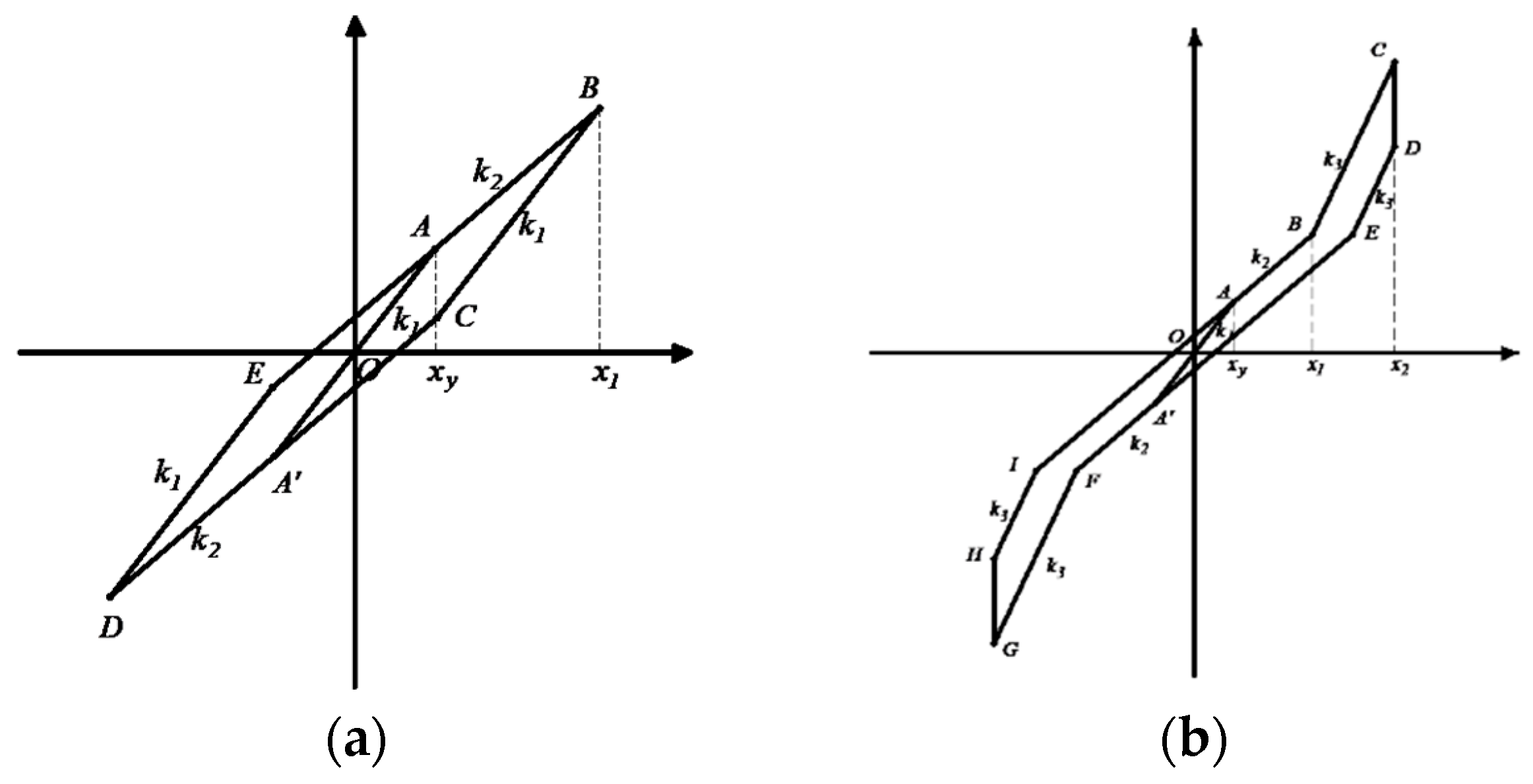
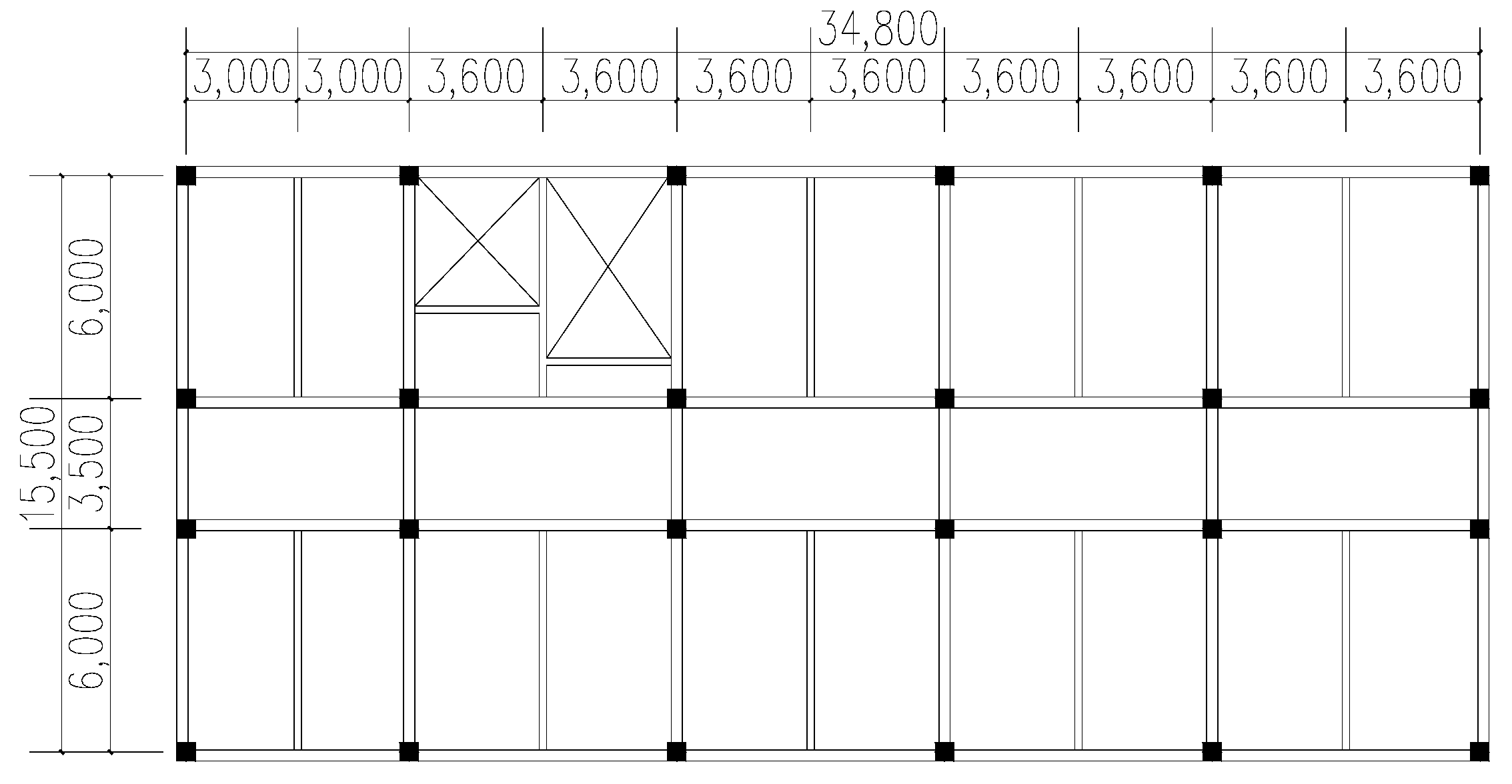
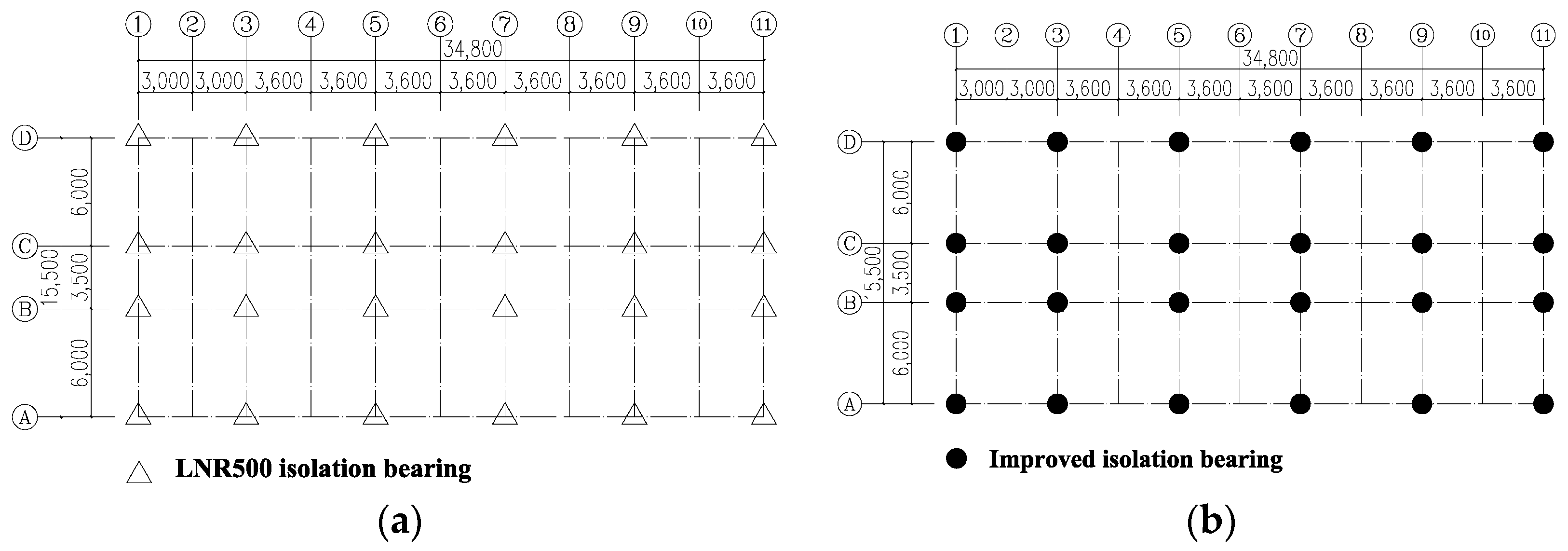



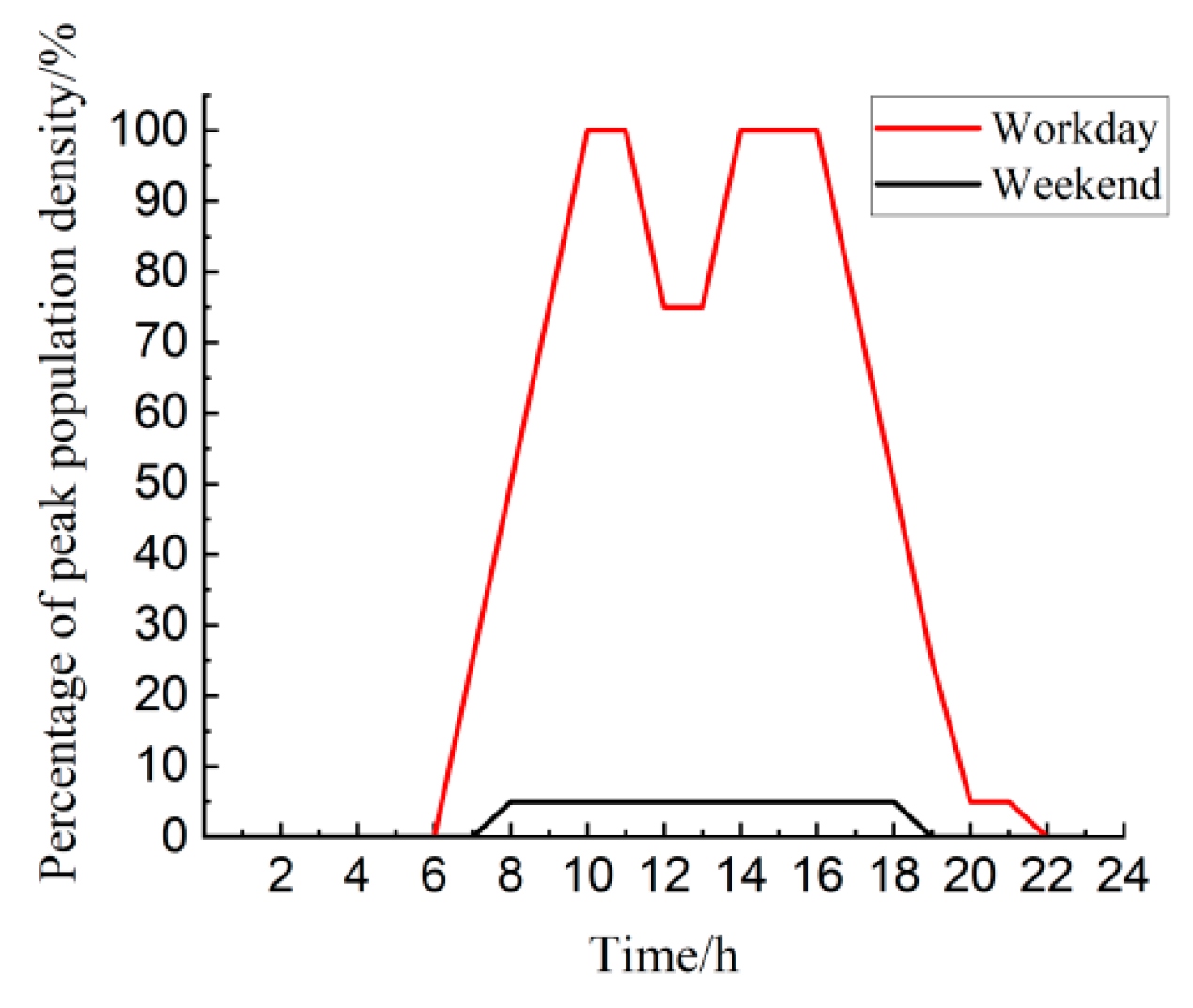
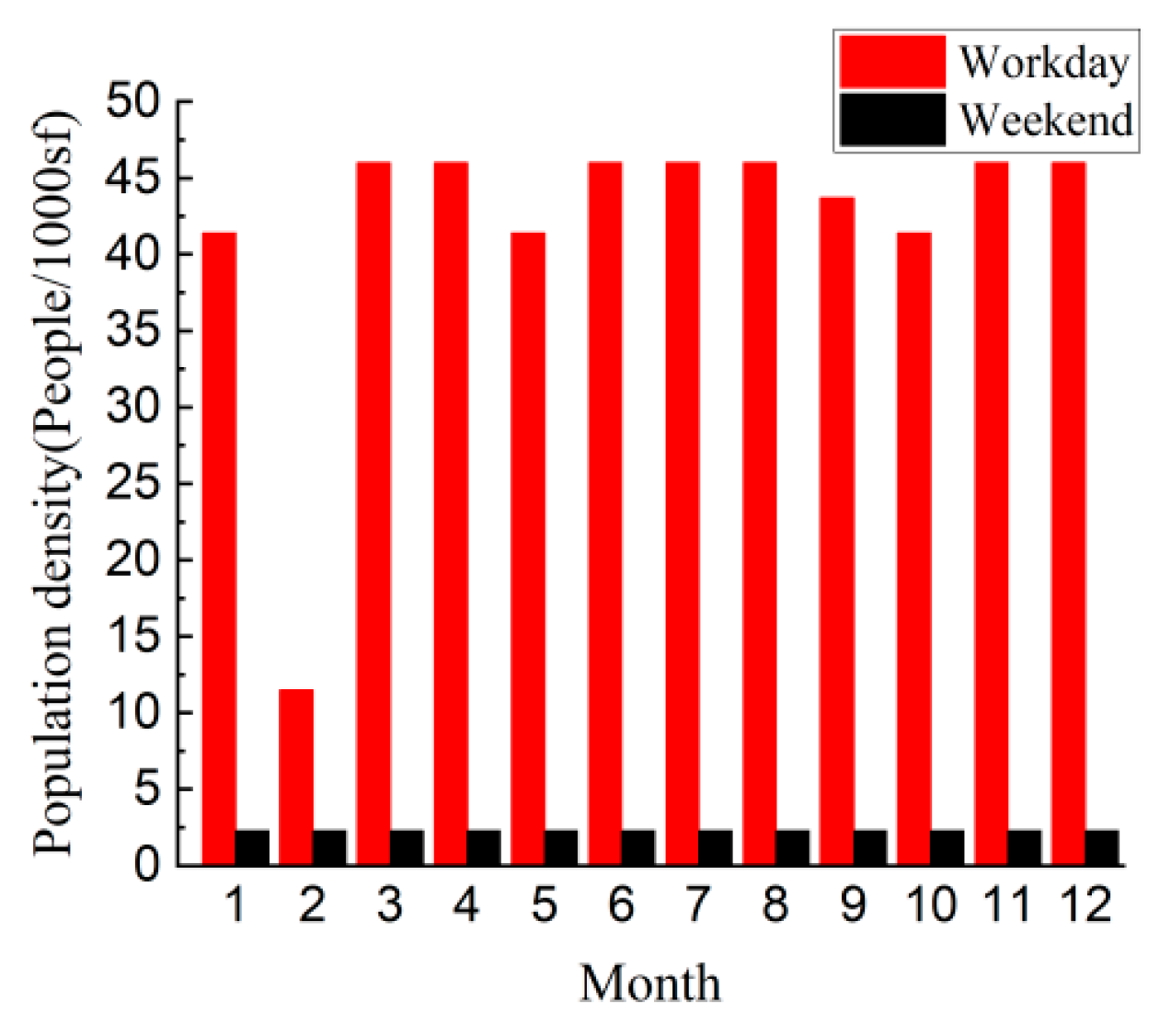
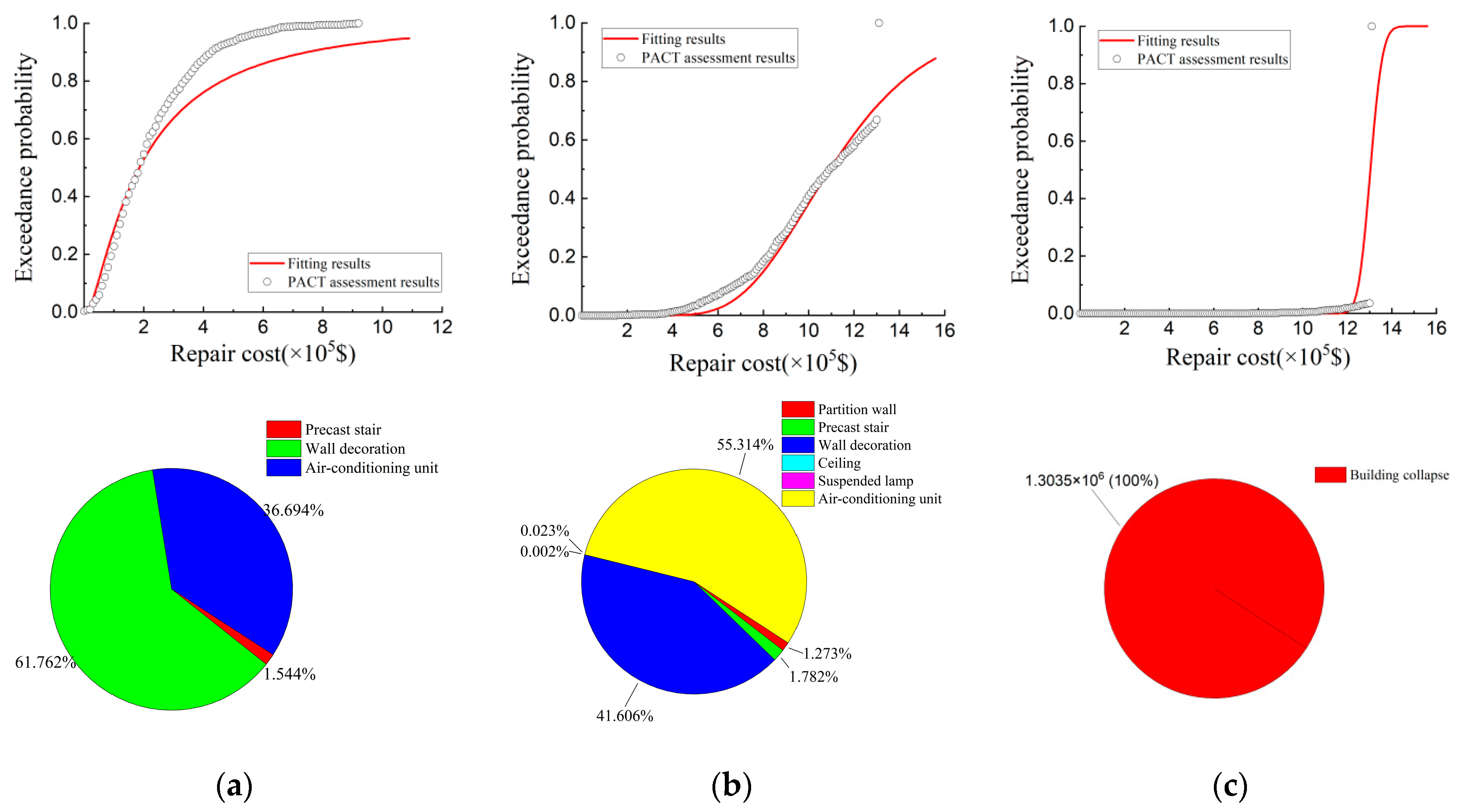
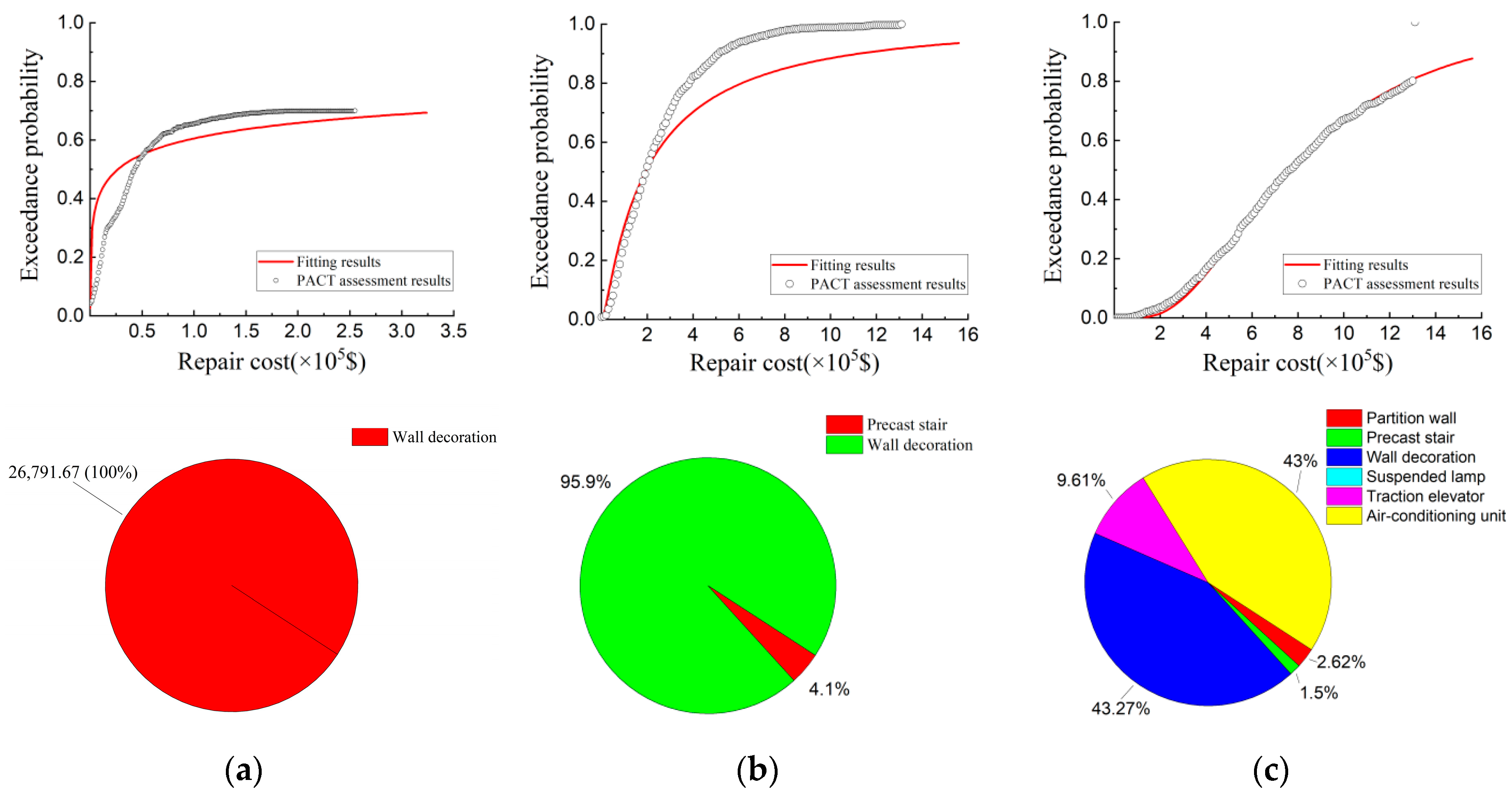
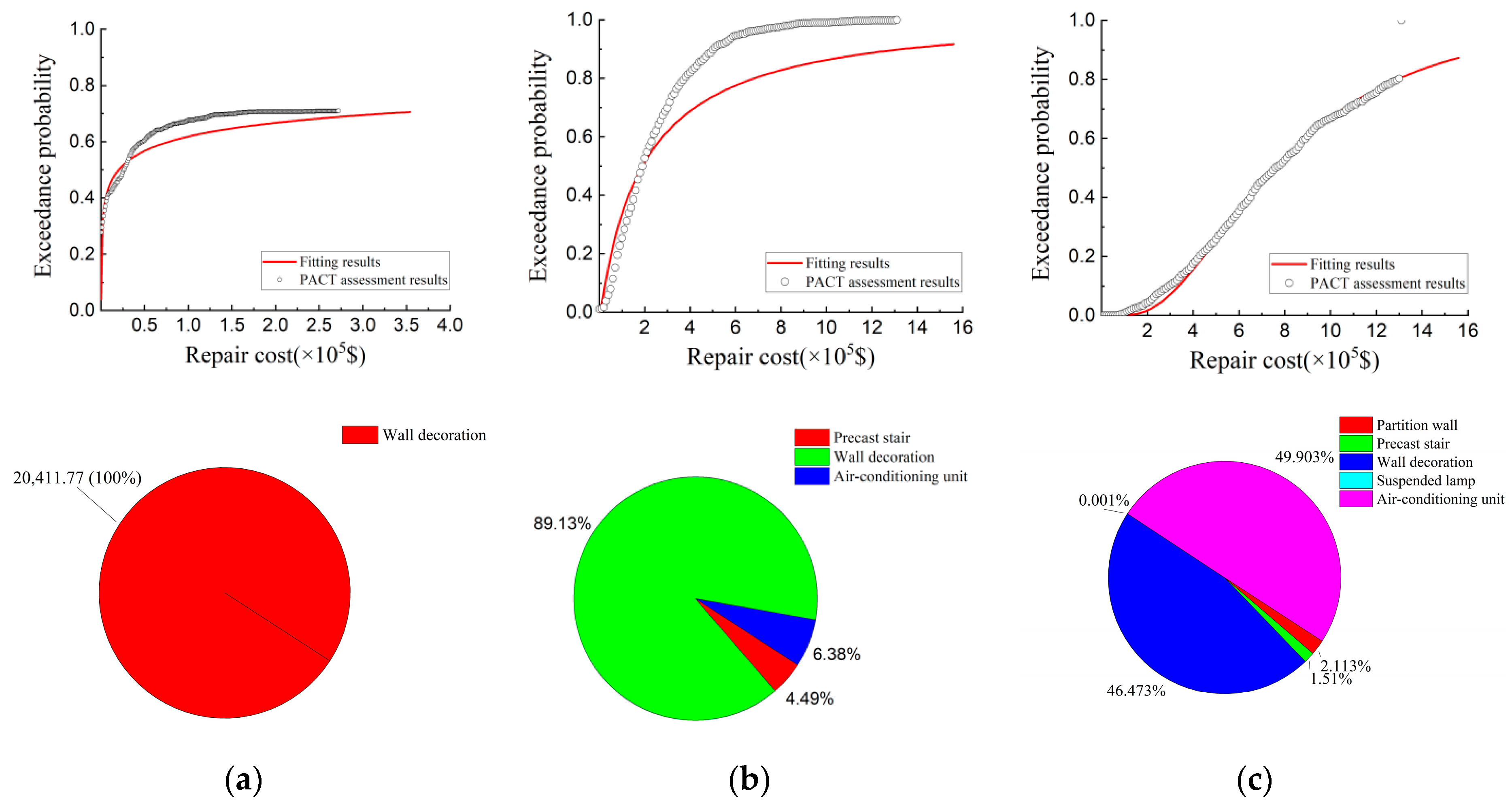

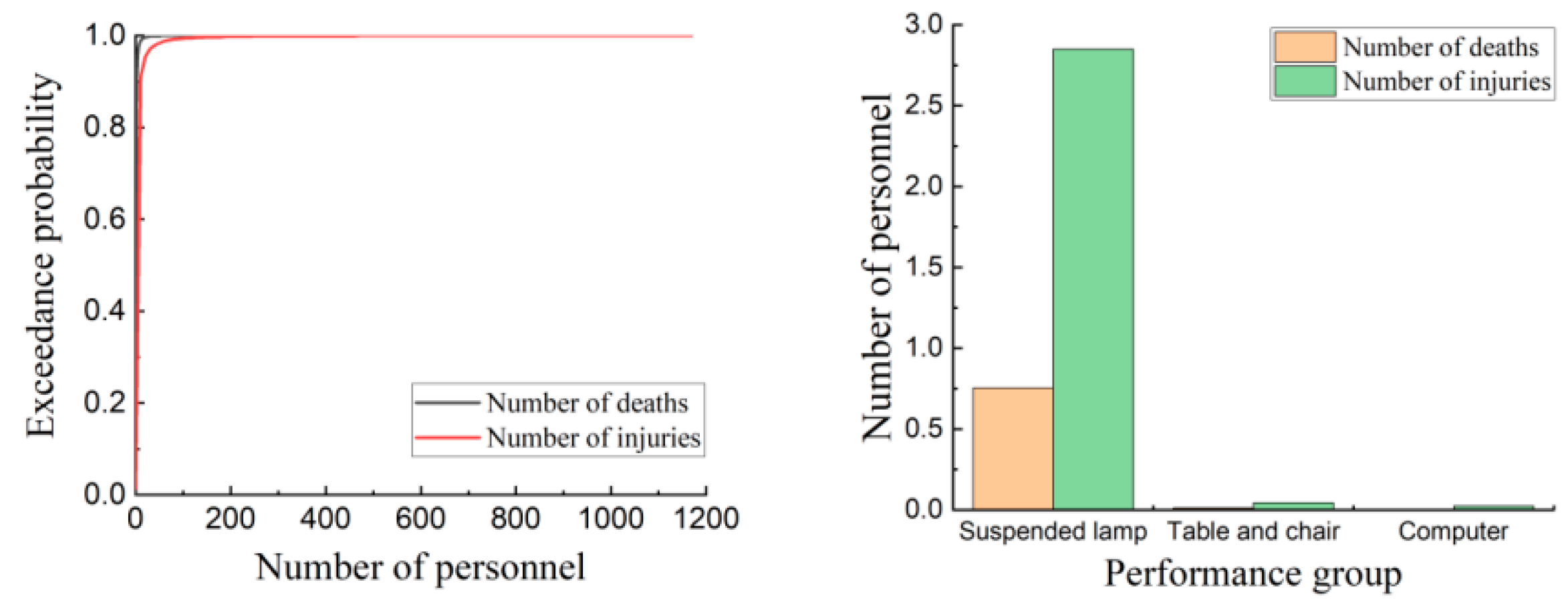

| Shear Modulus of Rubber (MPa) | C10 | C01 | D1 | J | E0/GPa |
|---|---|---|---|---|---|
| 0.55 | 0.22 | 0.055 | 0.001 | 1 | 1.65 |
| 0.35 | 0.14 | 0.035 | 0.001 | 1 | 1.05 |
| Type | Effective Diameter (mm) | Central Aperture (mm) | Rubber Layer Thickness (mm) | Steel Plate Thickness (mm) | Sealing Plate Thickness (mm) | Number of Rubber Layers | Number of Steel Plate Layers |
|---|---|---|---|---|---|---|---|
| Improved rubber bearing | 500 | 80 | 5 | 2.5 | 20 | 20 | 19 |
| Compressive Stress (MPa) | Vertical Displacement (mm) | Vertical Load (kN) | Vertical Compression Stiffness |
|---|---|---|---|
| 5 | 0.27095 | 981.748 | 3623.35 |
| 10 | 0.54177 | 1963.50 | 3624.23 |
| 12 | 0.65006 | 2356.19 | 3624.57 |
| 15 | 0.81246 | 2945.24 | 3625.09 |
| Model | Initial Stiffness k1 (kN/mm) | Theoretical Calculation k1c (kN/mm) | Yield Stiffness k2 (kN/mm) | Theoretical Calculation k2c (kN/mm) | Yield Stiffness k3 (kN/mm) | Theoretical Calculation k3c (kN/mm) |
|---|---|---|---|---|---|---|
| U55B20 | 0.7438 | 0.7653 | 0.5553 | 0.5612 | 2.1368 | 2.1046 |
| U55B25 | 0.9360 | 0.9566 | 0.6514 | 0.6577 | 2.1367 | 2.1046 |
| U55B30 | 1.1171 | 1.1479 | 0.7372 | 0.7428 | 2.1425 | 2.1046 |
| U55B35 | 1.2991 | 1.3393 | 0.8222 | 0.8184 | 2.1464 | 2.1046 |
| U60B35 | 1.3069 | 1.3393 | 0.8375 | 0.8458 | 2.3368 | 2.2959 |
| U65B35 | 1.3073 | 1.3393 | 0.8612 | 0.8705 | 2.5273 | 2.4872 |
| U70B35 | 1.3076 | 1.3393 | 0.8858 | 0.8928 | 2.7097 | 2.6785 |
| Statistics | Model | ||||||
|---|---|---|---|---|---|---|---|
| U55B20 | U55B25 | U55B30 | U55B35 | U60B35 | U65B35 | U70B35 | |
| Average value | 0.9922 | 0.9947 | 0.9946 | 0.9982 | 0.9946 | 0.9939 | 0.9934 |
| Standard deviation | 0.0218 | 0.0188 | 0.0225 | 0.0256 | 0.0214 | 0.0204 | 0.0177 |
| Coefficient of variation | 0.0220 | 0.0189 | 0.0226 | 0.0256 | 0.0215 | 0.0205 | 0.0178 |
| Number | Frequent Earthquakes | Fortification Earthquakes | Rare Earthquakes |
|---|---|---|---|
| RSN40 | 5.55 | 15.61 | 35.21 |
| RSN55 | 7.61 | 21.39 | 48.26 |
| RSN68 | 4.08 | 11.48 | 25.90 |
| RSN97 | 0.28 | 0.78 | 1.77 |
| RSN339 | 0.12 | 0.33 | 0.75 |
| A04 | 0.48 | 1.35 | 3.04 |
| A05 | 0.21 | 0.58 | 1.30 |
| Performance Index | Intact Condition | Slight Failure | Moderate Failure | Serious Failure |
|---|---|---|---|---|
| Story drift angle | 1/550 | 1/250 | 1/120 | 1/50 |
| Structure Category | Intact Condition | Slight Failure | Moderate Failure | Serious Failure |
|---|---|---|---|---|
| Normal frame structure | 0.07 | 0.37 | 0.45 | 0.85 |
| Normal isolation structure | 0.2 | 0.42 | 0.91 | 1.15 |
| Improved isolation structure | 0.21 | 0.45 | 0.92 | 1.35 |
| Name | Parameter |
|---|---|
| Building name | Scientific research office building |
| Structure type | Cast-in-place concrete structure |
| Number of layers | 6 |
| Floor height/m | 3.6/3.3 |
| Floor area/m2 | 539.4 |
| Building reconstruction cost/Million dollars | 1.3035 |
| Building reconstruction time/day | 375 |
| Maximum number of workers per square meter | 0.02 |
| Vulnerability Groups | Number of Vulnerable Groups | Unit | Quantity | ||||||
|---|---|---|---|---|---|---|---|---|---|
| Type | Member | 1st Floor | 2nd Floor | 3rd Floor | 4th Floor | 5th Floor | 6th Floor | ||
| structural member | Beam-column joint (a) | B1041.032a | 1 EA | 8 | 8 | 8 | 8 | 8 | 8 |
| Beam-column joint (b) | B1041.032b | 1 EA | 16 | 16 | 16 | 16 | 16 | 16 | |
| non-structural member | Exterior wall | B2011.201a | 30 LF | 7.61 | 7.61 | 7.61 | 7.61 | 7.61 | 7.61 |
| Partition wall | C1011.001a | 100 LF | 2.05 | 2.28 | 2.28 | 2.28 | 2.28 | 2.28 | |
| Wall decoration | C3011.002c | 100 LF | 4.33 | 4.56 | 4.56 | 4.56 | 4.56 | 4.56 | |
| Ceiling | C3032.001a | 250 SF | 20.90 | 20.90 | 20.90 | 20.90 | 20.90 | 20.90 | |
| Hot water pipe | D2022.011a | 1000 LF | 0.26 | 0.26 | 0.26 | 0.26 | 0.26 | 0.26 | |
| Sewage pipe | D2031.011b | 1000 LF | 0.10 | 0.10 | 0.10 | 0.10 | 0.10 | 0.10 | |
| Ventilation tube | D3041.011a | 1000 LF | 0.17 | 0.17 | 0.17 | 0.17 | 0.17 | 0.17 | |
| Firehose pipeline | D4011.021a | 1000 LF | 0.35 | 0.35 | 0.35 | 0.35 | 0.35 | 0.35 | |
| Precast stair | C2011.001b | 1 EA | 1 | 1 | 1 | 1 | 1 | 1 | |
| Traction elevator | D1014.011 | 1 EA | 1 | - | - | - | - | - | |
| Item inside the building | Suspended lamp | C3034.001 | 1 EA | 28 | 28 | 28 | 28 | 28 | 28 |
| Air-conditioning unit | D3052.011a | 4000 CF | 17 | 15 | 15 | 15 | 15 | 15 | |
| Diesel generator | D5092.031a | 250 KV | 2 | 2 | 2 | 2 | 2 | 2 | |
| Computer | E2022.022 | 1 EA | 25 | 27 | 27 | 27 | 27 | 27 | |
| Table and chair | E2022.020 | 1 EA | 40 | 44 | 44 | 44 | 44 | 44 | |
| Earthquake Intensity | Type of Structures | ||
|---|---|---|---|
| Normal Frame Structure (×103 $) | Normal Isolation Structure (×103 $) | Improved Isolation Structure (×103 $) | |
| Frequent earthquake | 18.47 | 2.68 | 2.04 |
| Fortification earthquake | 109.14 | 19.31 | 19.00 |
| Rare earthquake | 130.15 | 76.25 | 75.77 |
| Earthquake Intensity | Normal Frame Structure | Normal Isolation Structure | Improved Isolation Structure | |||
|---|---|---|---|---|---|---|
| Number of Deaths | Number of Injuries | Number of Deaths | Number of Injuries | Number of Deaths | Number of Injuries | |
| Frequent earthquake | - | - | - | - | - | - |
| Fortification earthquake | 1.70 | 5.92 | - | - | - | - |
| Rare earthquake | 5.57 | 16.29 | - | - | - | - |
| = 1.2 g | - | - | 0.76 | 2.91 | 0.36 | 1.84 |
Disclaimer/Publisher’s Note: The statements, opinions and data contained in all publications are solely those of the individual author(s) and contributor(s) and not of MDPI and/or the editor(s). MDPI and/or the editor(s) disclaim responsibility for any injury to people or property resulting from any ideas, methods, instructions or products referred to in the content. |
© 2023 by the authors. Licensee MDPI, Basel, Switzerland. This article is an open access article distributed under the terms and conditions of the Creative Commons Attribution (CC BY) license (https://creativecommons.org/licenses/by/4.0/).
Share and Cite
Huang, J.; Wang, P.; Shi, Q.; Rong, C.; Wang, B. Mechanical Properties and Seismic Loss Assessment of Improved Isolation Bearing with Variable Stiffness. Buildings 2023, 13, 1134. https://doi.org/10.3390/buildings13051134
Huang J, Wang P, Shi Q, Rong C, Wang B. Mechanical Properties and Seismic Loss Assessment of Improved Isolation Bearing with Variable Stiffness. Buildings. 2023; 13(5):1134. https://doi.org/10.3390/buildings13051134
Chicago/Turabian StyleHuang, Jie, Peng Wang, Qingxuan Shi, Chong Rong, and Bin Wang. 2023. "Mechanical Properties and Seismic Loss Assessment of Improved Isolation Bearing with Variable Stiffness" Buildings 13, no. 5: 1134. https://doi.org/10.3390/buildings13051134
APA StyleHuang, J., Wang, P., Shi, Q., Rong, C., & Wang, B. (2023). Mechanical Properties and Seismic Loss Assessment of Improved Isolation Bearing with Variable Stiffness. Buildings, 13(5), 1134. https://doi.org/10.3390/buildings13051134





